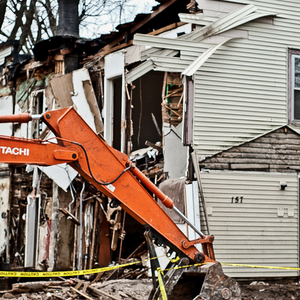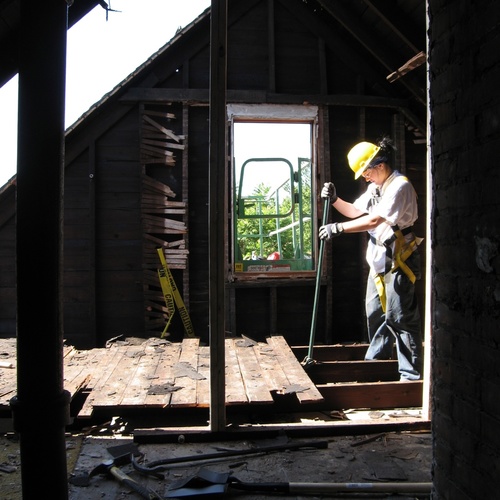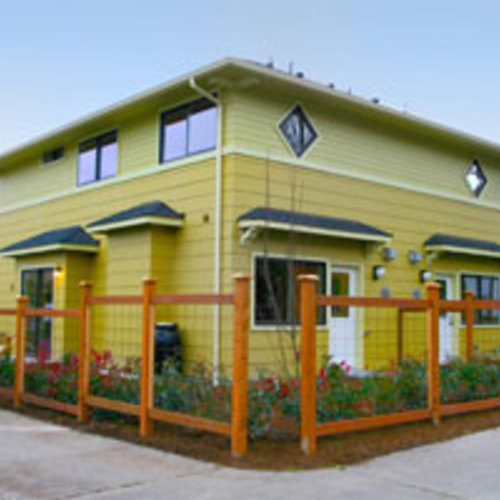
This post originally appeared at Ensia.
Just a few years after starting a non-profit reselling used building materials in the early 1990s, Ted Reiff’s organization, The ReUse People, hit a wall. “We couldn’t get enough materials to supply the demand,” he says.
Despite tons of donated and salvaged doors, windows, and structural beams coming in to his San Diego-based operation, the number of people seeking cheap materials for homebuilding and renovation projects was overwhelming. “We were constantly getting cleared out every day.”
So Reiff got a demolition license. But unlike traditional demolition crews that simply knock buildings down with a backhoe, Reiff’s approach was to gradually disassemble the structures, carefully extracting saleable materials like a miner plucking gold nuggets from the ground. Reiff’s company became specialists in a relatively new concept known as deconstruction: dismantling homes piece by piece to preserve the abundant reusable components within.
Reiff was just trying to augment his supplies, but it didn’t take long to realize the broader benefits of what he was doing. Deconstructing a house meant not only that people could get affordable access to building materials, but also that those materials didn’t end up in a landfill — the end point for an estimated 500 million tons (454 million metric tons) of demolition waste in the U.S. annually. Every piece of material saved meant one fewer part that needed to be manufactured, cutting down the use of raw resources and the energy required to process them. And every home deconstructed created about twice as many jobs as a demolition.
Today, more than 20 years after Reiff first started reselling used building materials, deconstruction is slowly being recognized as the environmentally and economically sound solution to the wasteful problem of demolition waste.
“When we started, we were one of just a few people. Now there’s an association of us and there’s probably a hundred members,” Reiff says. His company alone conducts about 250 deconstructions a year.
Deconstruction is not the norm
But deconstruction is far from mainstream. “In terms of activity around the world, this is not something that’s taken root,” says Charles Kibert, professor of engineering and director of the Powell Center for Construction & Environment at the University of Florida. Deconstruction takes longer than demolition and can cost twice as much. Though homeowners can offset these costs through tax-deductible donations of salvaged building materials to organizations like Reiff’s, the extra time and effort required can be a deterrent, Kibert says.
A bigger barrier, though, is the way buildings are built, he says. Especially in the post-World War II era, cheaper materials and chemical-based glues and fire retardants have rendered many of a building’s components either worthless or too costly to process.
“What we’re suffering from in the building industry is not necessarily planned obsolescence, it’s just garbage,” says Kent Wilson, an R&D Design Specialist at the University of California, Berkeley’s Jacobs Institute for Design Innovation. “We’re talking about baseboards that are made out of fiberboard and plastics that are just not reusable.”
Many buildings, particularly those built before the 1940s, are full of valuable resources. And yet many of them are still going to waste, especially in struggling economies littered with abandoned homes.
This is the case in Milwaukee. “You’ve got three- and four-hundred-year-old white pine going to the landfill,” says Robert Bauman, an alderman on the city’s common council. “It’s rather tragic, actually.”
Bauman says the city has nearly 200 abandoned homes in need of immediate demolition and perhaps thousands more facing imminent raze orders, so he proposed legislation to deconstruct any home on the list built before 1930, thereby pulling out this old-growth lumber and diverting reusable resources from the dumps. And, in an economically struggling inner city, deconstruction offered the added bonus of providing jobs.
“If we can put ex-offenders to work doing legitimate, useful things for a family-supporting wage and getting them on a path to regular employment in the construction industry, everybody saw the benefit of that,” he says. The ordinance passed unanimously and was enacted earlier this year.
Labor-intensive work holds opportunities
“The thing about reusing materials is it’s all labor,” says Pam Howland, founder of Old Window Workshop, a restoration business in Springfield, Massachusetts.
Old Window Workshop’s mission is to provide jobs to women, training them to rebuild and restore antique windows that are pulled out of buildings undergoing renovation or deconstruction. For Howland, the goal is partly to reduce waste, but also to help low-income women develop new skills. “This is Springfield. We’re located in the lowest income neighborhood in the state,” Howland says. “It’s very easy to find folks who need work in the middle of this city, and every city, really.”
Finding a steady stream of projects, though, has been challenging. Howland says a project to replace hundreds of windows on Springfield’s city hall has stalled for months. And even though it can be cheaper to restore existing windows on older buildings, Howland says many people still opt for the faster solution of buying new windows and sending the old ones to the dump.
Barriers that remain
Despite deconstruction’s environmental and social benefits, many barriers are still holding it back — from demand to cost to arcane stipulations in building codes. In Milwaukee, nearly a year since the deconstruction ordinance was enacted, only a handful of private buildings have gone through the process, according to Bauman. Of the many buildings on the city’s rolls, he says none have been deconstructed.
“As is often the case with these sustainability initiatives and any other out-of-the-box ideas, you run into a plethora of bureaucratic opposition,” says Bauman. Because of specific rules for dealing with asbestos and other contaminants like lead paint, the deconstruction of publicly owned buildings has turned out to be about twice as expensive as privately-owned homes, according to Bauman.
“If we don’t get the prices reduced then the program probably falls apart and we go back to the old way of just throwing stuff in a landfill,” he says.
Progress has been slow. “I’ve been at this now 25 years,” says Reiff of The ReUse People. “If I knew it was going to be this tough, I don’t know whether I would have started it or not.”
But there are signs of hope. Reiff’s company has recently expanded into Canada. Vancouver was one of the first cities to enact a deconstruction ordinance, and Reiff expects to deconstruct about 40 homes there in its first year. In Portland, Oregon, which preceded Milwaukee in requiring some deconstruction, about 80 homes were permitted for deconstruction in the first year since its ordinance was enacted, diverting an estimated 2,500 tons (2,200 metric tons) of material from the landfill.
“Legislation is kicking in in a lot of places,” Reiff says. “And the more that happens, the more deconstruction and building material salvage will move to the forefront.”
Nate Berg is a writer who covers cities, sciences and design.
Weekly Newsletter
Get building science and energy efficiency advice, plus special offers, in your inbox.















14 Comments
One would be surprised at the amount of people who will show up to help deconstruct for free if you put the word out. Our old barn had a number of Mennonites show up to take useful boards, beams and sheet metal before the rest was demolished.
An ad put up on Kijiji led to a number of people showing up to take items from the house when it was its turn to go. Not a full deconstruction, but anything that can go to help others and stay out of a landfill is a win in my books.
Jaccen,
I'm all in favor of a good old fashioned Mennonite deconstruction party, but homeowners should be aware of possible liability issues that accompany an invitation to "come to our deconstruction site and take what you want." Your homeowner's insurance policy may or may not cover you if someone is injured after you issue such an invitation.
A great deconstruction/Design-Build program at Carnegie Mellon U..... Project Re_. Headed up by John Folan. http://www.projectrepgh.com. Best, Jim@475 High Performance Building
You definitely DO NOT want to post the words "free" and your address on Craigs List. The horde of strange people that will show up at your doorstep is something you will regret.
Like Martin mentioned, if someone gets hurt, you will get sued and your homeowners insurance might not cover it. You should have at least $500,000 in coverage for stuff like personal injuries.
I asked my local building department under what circumstances they would allow me to use salvaged lumber for a porch roof addition, and they said absolutely not. So where is the market for salvaged lumber?
Charles,
You're right that the market for salvaged lumber is limited. Salvaged framing lumber can be used for projects in rural areas that aren't subject to building codes. Salvaged boards can be used anywhere as interior paneling.
Here in BC any lumber that isn't stamped can be used if it is graded. That includes salvaged lumber and any cut on site by mobile sawmills. In rural areas like mine with lots of of forestry, it is quite easy to get someone to grade it.
Martin,
Definitely agree on the liability. For the house, we personally removed the items and placed them at the roadway for people to pick up. No one came onto the property. "Junk at road" ad was put up.
The Mennonite situation was a word-of-mouth instance. Liability? Yes. Concern for us? No. We, perhaps naively, view our immediate neighbours as.........neighbours. We realize that word means different things to different people (ie. some take Robert Frost's "Mending Walls" quite differently in how it applies to their lives). That being said, we would have done so again.
Quite a bit of my design jobs are for tear-downs/new build houses in big cities. Must demolition contractors try to save as much materials to donate, get tax credits or sale to supplement their gains to the tear-down job. Not all is lost in this world.
Martin,
In Fine Homebuilding Podcast Episode 105, you stated, "You can get recycled rigid foam now for next to nothing, for 1/3 of the price of new foam." Where should I be looking for salvaged foam?
Charles,
Did I really say that? If so, I'd like to apologize for my inaccurate and misleading statement. I thought I said, "For about 1/3 to 1/2 the price of new foam." If I said "next to nothing," I was wrong.
To buy salvaged foam, Google "Insulation Depot," or look for rigid foam on Craigs List.
I can get factory-seconds foam from local suppliers at about half retail.
Reclaimed foam is typically 1/4-1/3 the cost of new foam (compared to distributor pricing, not box store pricing.)
If running a craigslist search I usually use rigid + insulation rather than rigid + foam, both are reasonably selective. eg:
https://atlanta.craigslist.org/search/sss?query=rigid+insulation
https://atlanta.craigslist.org/search/sss?query=rigid+foam
https://northmiss.craigslist.org/search/sss?query=rigid+insulation
https://northmiss.craigslist.org/search/sss?query=rigid+foam
Charles, get to know a large roofing company. Especially for recycled Polyiso. I can get 2-3'' 4x8' sections for $3-4 (10-13 cents per sq. ft.). That's pretty next to nothing. They usually know the exact age as well because they have return customers. Two now call me when they have a job so I can get the best pick of the crop. I always leave a case of Guiness for there help.
Thanks, Paul. By "large", do you mean commercial rather than residential? Why is the exact age important?
Log in or create an account to post a comment.
Sign up Log in